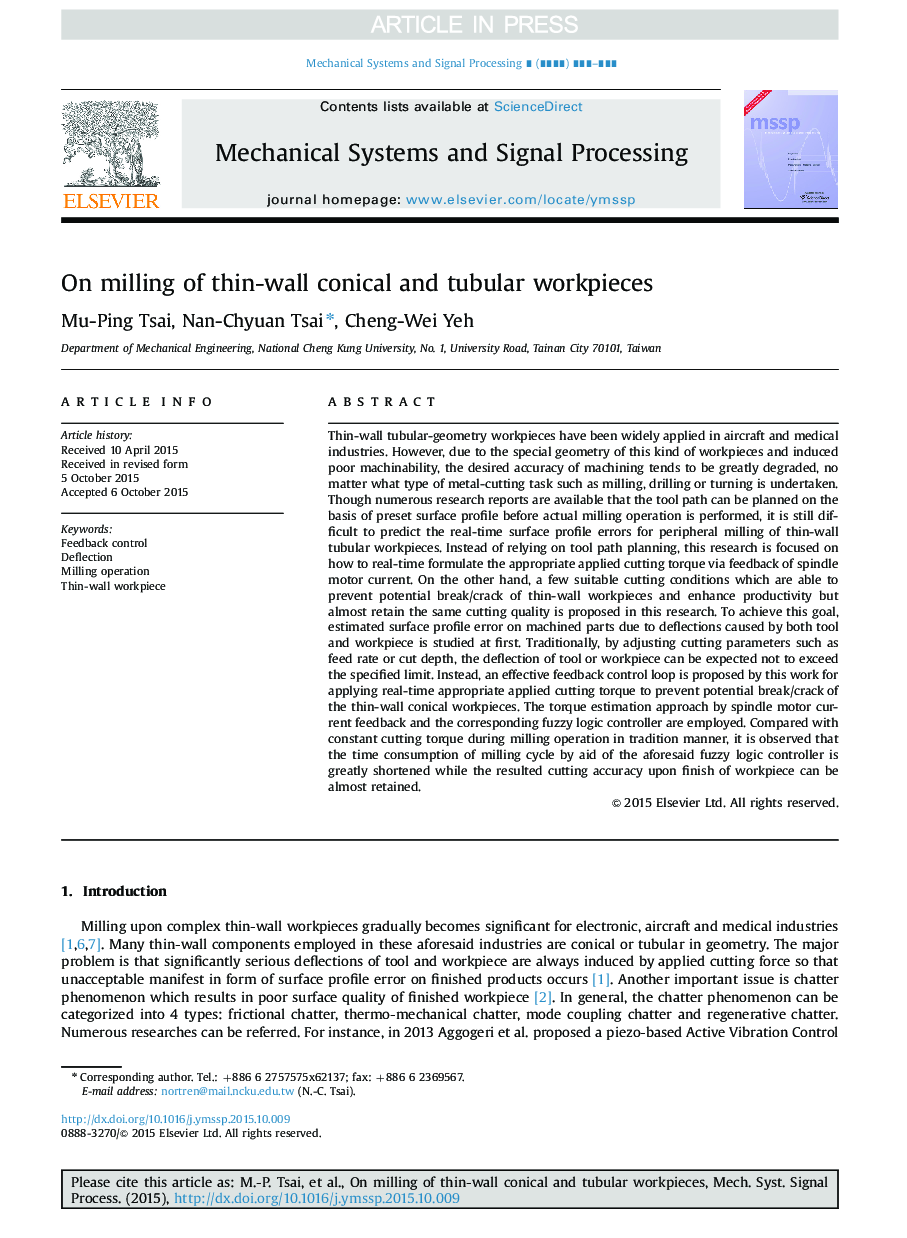| کد مقاله | کد نشریه | سال انتشار | مقاله انگلیسی | نسخه تمام متن |
|---|---|---|---|---|
| 6955410 | 1451858 | 2016 | 14 صفحه PDF | دانلود رایگان |
عنوان انگلیسی مقاله ISI
On milling of thin-wall conical and tubular workpieces
ترجمه فارسی عنوان
در مورد فرزکاری قطعات نازک و مخروطی و لوله ای
دانلود مقاله + سفارش ترجمه
دانلود مقاله ISI انگلیسی
رایگان برای ایرانیان
کلمات کلیدی
کنترل بازخورد، انحراف، عملیات فرزکاری، قطعه نازک دیوار،
ترجمه چکیده
قطعات دایره ای لوله دودی نازک به طور گسترده ای در هواپیما و صنایع پزشکی کاربرد دارند. با این حال، با توجه به هندسه ویژه این نوع قطعات و ماشینکاری ضعیف ناشی از آن، دقت مورد نظر ماشینکاری به شدت کاهش می یابد، مهم نیست که چه نوع کار برش فلز مانند فرز، حفاری و یا چرخش انجام شود. اگرچه گزارش های تحقیقاتی متعددی در دسترس است که مسیر ابزار را می توان بر اساس مشخصات سطح پیش تعیین شده قبل از عملیات فرزکاری واقعی برنامه ریزی کرده است، هنوز مشکل است که خطاهای نمایه سطح در زمان واقعی را برای فرزکاری محصور قطعات تهیه شده از لوله های نازک پیش بینی کنیم. به جای تکیه بر برنامه ریزی مسیر ابزار، این تحقیق بر روی چگونگی زمانبندی گشتاور برشی اعمال شده از طریق بازخورد جریان موتور اسپیندل متمرکز شده است. از سوی دیگر، چندین شرایط برش مناسب که قادر به جلوگیری از شکستن / کرک شدن قطعه های نازک دیوار و افزایش بهره وری هستند، اما تقریبا همان کیفیت برش را حفظ می کنند، در این تحقیق پیشنهاد شده است. برای رسیدن به این هدف، خطای پروفیل تخمینی بر روی قطعات مکانیکی به دلیل انحرافات ناشی از هر دو ابزار و قطعه کار در ابتدا مورد بررسی قرار گرفته است. به طور سنتی، با تنظیم پارامترهای برش مانند سرعت تغذیه یا عمق برش، انتظار می رود که انحراف ابزار یا قطعه کار از حد مشخص تعریف نشود. در عوض، یک حلقه کنترل بازخورد موثر توسط این کار برای استفاده از گشتاور برشی مورد استفاده مناسب در زمان واقعی برای جلوگیری از شکستن / کرک شدن قطعه های مخروطی نازک دیوار پیشنهاد شده است. رویکرد برآورد گشتاور بوسیله بازخورد جریان موتور اسپیندل و کنترل منطقی فازی منطقی مورد استفاده قرار می گیرد. در مقایسه با گشتاور برشی ثابت در طول عملیات آسیاب به روش سنتی، مشاهده شده است که مصرف زمان چرخه میلز با کمک کنترل کننده منطقی فاز تا حد زیادی کوتاه می شود، در حالی که دقت برش بر روی پایان کار قطعه می تواند تقریبا حفظ شود.
موضوعات مرتبط
مهندسی و علوم پایه
مهندسی کامپیوتر
پردازش سیگنال
چکیده انگلیسی
Thin-wall tubular-geometry workpieces have been widely applied in aircraft and medical industries. However, due to the special geometry of this kind of workpieces and induced poor machinability, the desired accuracy of machining tends to be greatly degraded, no matter what type of metal-cutting task such as milling, drilling or turning is undertaken. Though numerous research reports are available that the tool path can be planned on the basis of preset surface profile before actual milling operation is performed, it is still difficult to predict the real-time surface profile errors for peripheral milling of thin-wall tubular workpieces. Instead of relying on tool path planning, this research is focused on how to real-time formulate the appropriate applied cutting torque via feedback of spindle motor current. On the other hand, a few suitable cutting conditions which are able to prevent potential break/crack of thin-wall workpieces and enhance productivity but almost retain the same cutting quality is proposed in this research. To achieve this goal, estimated surface profile error on machined parts due to deflections caused by both tool and workpiece is studied at first. Traditionally, by adjusting cutting parameters such as feed rate or cut depth, the deflection of tool or workpiece can be expected not to exceed the specified limit. Instead, an effective feedback control loop is proposed by this work for applying real-time appropriate applied cutting torque to prevent potential break/crack of the thin-wall conical workpieces. The torque estimation approach by spindle motor current feedback and the corresponding fuzzy logic controller are employed. Compared with constant cutting torque during milling operation in tradition manner, it is observed that the time consumption of milling cycle by aid of the aforesaid fuzzy logic controller is greatly shortened while the resulted cutting accuracy upon finish of workpiece can be almost retained.
ناشر
Database: Elsevier - ScienceDirect (ساینس دایرکت)
Journal: Mechanical Systems and Signal Processing - Volumes 72â73, May 2016, Pages 395-408
Journal: Mechanical Systems and Signal Processing - Volumes 72â73, May 2016, Pages 395-408
نویسندگان
Mu-Ping Tsai, Nan-Chyuan Tsai, Cheng-Wei Yeh,
